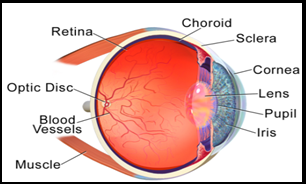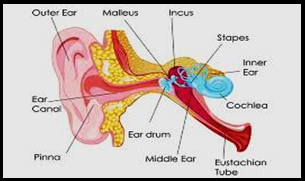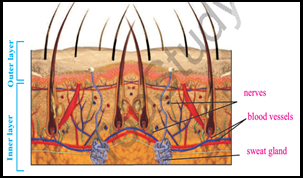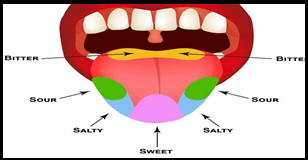

Sense Organ
There are five sense
organs in humans. (Eye, Nose, Ear, Tongue, and skin)
EYE
Eye consists of three coats
(a) Sclerotic (b) Choroid (c) Retina
Sclerotic: The Sclerotic
layer is the outermost white part of the eye, it protect
the inner part of the eye.
The cornea is the
transparent front part of the eye that covers the iris and pupil.
Colored part of eye is
called iris.
The dark whole of the iris
is called pupil.
Behind the
pupil lies a lens which is attached to muscles.
Choroid: Choroid is the middle
layer of the eye.
Choroid color is black.
The Choroid is filled
with blood vessels that bring oxygen and nourishment to the eye.
Vascular layer of the eye is
called choroid.
Retina: Inner most covering of the eye is called retina.
Image formed in eye
at the retina.
When light come from the external
object then it passed through retina.
Behind the retina are optic
nerves which take the signals to the brain and helps us to see object.
EAR
Ear consists of three
parts. (a) Outer ear (b) Middle ear (c)
Inner ear
Outer ear consists of pinna and a canal.
Where canal is end the ear drum is start.
The middle ear consists of three small bones
called ossicles.
The inner ear consists of three semicircular canals
and a coiled structure called cochlea.
Ear bones are the smallest bones of the body.
The inner ear also helps in maintaining the balance
of the body.
SKIN
Skin is the largest sense organ of our body.
The most sensitive area of our body is your hands, lips,
face, neck, tongue, and feet.
Skin has two main layers.
Epidermis: It is the outer layer of the skin and contains three
layers of cells.
Dermis: It is the lower layer of the skin which
contains sweat and oil glades, blood vessels, fat, and sensory cells
called receptors.
There are about 100 touch receptors in each of your
fingertips.
NOSE
Nose open outside through nostrils.Special
cells called receptors are located in the upper part
of the nostrils.
If your nose is at its best you can fell the difference between 4000
to 10000 smells.
TONGUE
Tongue has groups of sensory cell called taste
buds.
Tongue test of bitter (کڑوا) in his last
parts, salty (نمکین) and sweet (میٹھا) in front of tongue similarly
sour (تُرش ) in sides of
tongue.
We have almost 10000 taste insides our mouth even on
the roofs of our mouth.
We can sense different stimuli due to ………...
a) Sense organs
b) Blood
c) Environment
d) Nutrition
In the eye, sensory cells are located on……….
a) Choroid
b) Sclera
c) Iris
d) Retina
The optic nerves behind the retina take signals to the………………
a) Arm
b) Brain
c) Ear
d) Nose
Hearing is helped by…………………….
a) Optic nerve
b) Auditory nerve
c) Sensory nerve
d) none of these
Sweet taste buds lie at the……..of the tongue.
NTS PST 24/11/2019 (2:30)
a) tip
b) right side
c) left side
d) back